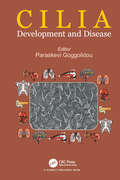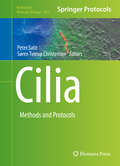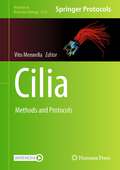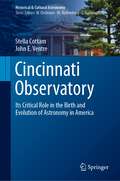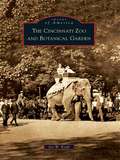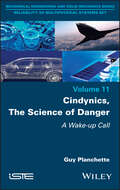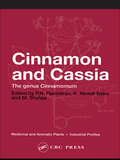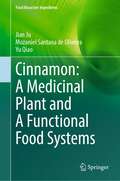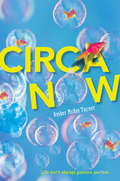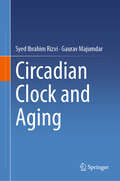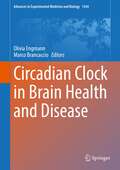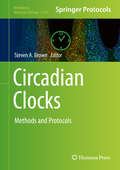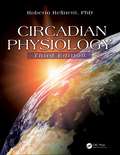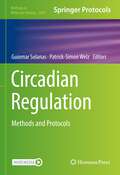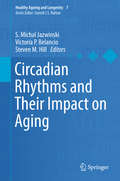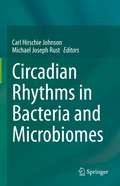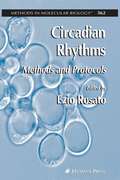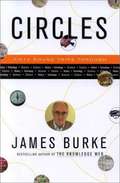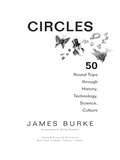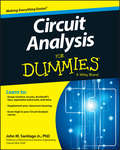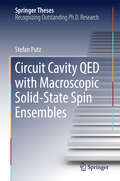- Table View
- List View
Cilia: Development and Disease
by Paraskevi GoggolidouThe scope of the book is to highlight the diverse roles of cilia in human development and disease. Almost all cell types form cilia and although they were first detected about 200 years ago, their significance was unclear. In the past ten years, it has become obvious that cilia have got sensory functions, as well as roles in motility and their mis-formation or the deregulation of the signaling pathways they control has been associated with defective development and human disease. Although research has concentrated on the role of the cilium in each organ, no effort has been made so far to bring all this information together and relate it to the various human diseases. This book aims to gather all the expertise that has been acquired on primary cilia and translate it into a medical and research context that will be of interest to postgraduate students, researchers, medics and scientists.
Cilia: Methods and Protocols (Methods in Molecular Biology #1454)
by Peter Satir Søren Tvorup ChristensenThis volume is the result of an explosion ofmolecular-based research on Cilia, which began with the discovery of theuniversality of intraflagellar transport (IFT) and ciliary genomics/proteomics. The chapters in this book cover topics such as: high resolution imaging andfunctional characterization of sensory and primary cilia in mammalian cells andzebrafish, methods to study ciliary-mediated chemoresponse in Paramecium,and methods to study centrosomes and cilia in C. elegans and Drosophila. Written in the highly successful Methods in Molecular Biology series format,chapters include introduction to their respective topics, lists of thenecessary materials and reagents, step-by-step, readily reproducible laboratoryprotocols, and tips on troubleshooting and avoiding known pitfalls. Practical and cutting-edge, Cilia:Methods and Protocols is broad and covers motile, sensory, and primarycells. It is a valuable resource to anyone interested in entering the field ofciliary biology using model organisms, including flagellate algae, ciliates,planaria, nematodes, insects, zebrafish, and mammalian cells.
Cilia: Methods and Protocols (Methods in Molecular Biology #2725)
by Vito MennellaThis volume covers the latest advancements in the study of ciliary complexity. Protocols cover genomic, proteomic, imaging, and functional analysis of different ciliated tissues and their wide applicability in cilia biology. Chapters in this book primarily focus on methods to study multiciliated cells, and discuss topics such as SARS-CoV-2 infections of human primary nasal multiciliated epithelial cells; expansion microscopy of ciliary proteins; live-imaging centriole amplification in mouse brain multiciliated cells; biophysical properties of cilia motility; and mucociliary transport device construction. Written in the highly successful Methods in Molecular Biology series format, chapters include introductions to their respective topics, lists of the necessary materials and reagents, step-by-step, readily reproducible laboratory protocols, and tips on troubleshooting and avoiding known pitfalls.Cutting-edge and thorough, Cilia: Methods and Protocols is a valuable resource for researchers who are interested in learning more about this developing field.
Cincinnati Observatory: Its Critical Role in the Birth and Evolution of Astronomy in America (Historical & Cultural Astronomy)
by Stella Cottam John E. VentrePreviously dependent on Europe for scientific knowledge, the United States came into its own during the nineteenth century. A prime example of this is evident in the establishment of the Cincinnati Observatory, in Cincinnati, Ohio. Funded by the citizenry of that city, it was initiated, with ceremony, by the oration by former President John Quincy Adams, at the laying of the cornerstone in 1843.In this book, you will read about the Cincinnati Observatory's most notable contributions, big and small, that were made over the course of its years in existence. You will learn about the Observatory's role in primitive weather forecasting, star cataloging, and even advancements it helped to create during World War II. Now known as the Cincinnati Observatory Center, it is a functional observatory and a dedicated center of astronomy education for all ages. It continues to contribute a rich cultural and scientific history to its community and nation.
Cincinnati Zoo and Botanical Garden, The
by Joy W. KraftOpening day, September 18, 1875, dawned sunless and chilly, a shaky start for the second zoological garden in the United States. Exhibits were unfinished, and animals remained crated. The polar bear had not arrived, and the collection on display included a feeble tiger, a blind hyena, an elephant rescued from a bankrupt circus, a talking crow, eight small monkeys, and 400 birds. Despite the rough start, the venture by bird-lover Andrew Erkenbrecher and friends blossomed into a top-tier zoo inspiring a passion for nature-a champion of endangered species with its own college-preparatory high school and an unrivaled commitment to education, research, and innovative breeding programs. It has survived The Perils of Pauline economics as stubborn Cincinnatians came to its rescue time after time, charmed by animals and events found here: chimps Mr. and Mrs. Rooney, Susie the Gorilla who took tea and smoked Chesterfields, Rodney the boxing kangaroo, Martha the last passenger pigeon on earth, outdoor operas, and dancing under the stars.
Cindynics, The Science of Danger: A Wake-up Call
by Guy PlanchetteThis book offers a new perspective to uncover the keys to accident and disaster avoidance. Created with a working group, it presents research and understanding on the root causes of disasters. Indeed, beyond technical failures, human beings are at the heart of organizations and, through the exchange of data and information, influential relationships inevitably emerge such as conflicts of interest and cooperation.With examples selected from multiple accidents and disasters, this book demonstrates that analyzing the causal chain that leads to an accident is not sufficient if we wish to truly understand it. The role of operational and managerial actors and the complexities they generate are also explored.Cindynics, The Science of Danger helps readers develop their ability to identify gaps, deficits, dissonances, disjunctions, degenerations and blockages, which are the real dangers in inevitably evolving activity situations. With an easily-understandable approach, this book offers new perspectives in several fields (health, crisis management and conflict resolution).
Cinnamon and Cassia: The Genus Cinnamomum (Medicinal And Aromatic Plants S. - Industrial Profiles Ser.)
by P. N. Ravindran K. Nirmal Babu M. ShylajaCinnamon and Cassia, the "Spices of Life", together constitute one of the most widely used group of spices. A comprehensive volume, Cinnamon and Cassia: Genus Cinnamomum explores in detail Srilankan cinnamon, Chinese cassia, Indonesian cassia, Indian cassia, camphor, and also the important related and useful spices of Cinnamomum.The introdu
Cinnamon: A Medicinal Plant and A Functional Food Systems (Food Bioactive Ingredients)
by Yu Qiao Mozaniel Santana de Oliveira Jian JuThis work addresses the multiple possibilities for using cinnamon for applications in food science technology and to help in the complimentary treatment and prevention of diseases, with priority given to secondary metabolites produced by this plant. Issues related to the functions of cinnamon and its applications, as well as the biosynthetic pathways of production by plants, are covered in depth. The link between food science and technology and specific medicinal plants has not been explored enough in the current literature, and this text looks to bridge this gap in its extensive coverage of cinnamon. CINNAMON: A Functional Food and Medicinal Plant provides readers with a broad and diverse overview of the importance of secondary metabolites produced by plants and the possibilities for innovative biotechnological approaches that introduce new potential to a wide range of industrial products. The application of cinnamon in products across food science and its numerous health benefits are outlined, including its use as a complimentary medicine for a number of diseases. This book features the main cinnamon varieties and production areas plus quality evaluation and bioactive compound extraction methods. The multiple applications of spices in foods are covered in depth, plus antioxidant activity and inhibitory effects on bacteria and fungi. Beyond its use in foods, readers will find chapters covering the antiviral effects of cinnamon and its use for the treatment and prevention of diabetes and other disorders. Also important is coverage on the safety aspects of cinnamon and its extracts. To date no book has exclusively covered the many uses of cinnamon and cinnamon extracts in food and pharmaceutical applications. This much-needed work provides a fully up to date and extensive overview for researchers to examine the many uses of cinnamon across multiple products and industries.
Cinnamon: Botany, Agronomy, Chemistry and Industrial Applications
by Ranjith Senaratne Ranjith PathiranaCinnamon is the common name for the spice obtained from the dried inner bark of several species of the genus Cinnamomum in the Lauraceae family. In world trade, Cinnamomum cassia (L.) J. Presl Cinnamomum burmannii dominate, but it is of a different quality to ‘true’ or ‘Ceylon’ cinnamon produced from Cinnamomum zeylanicum Blume (C. verum J. Presl), with the latter much easier to process, giving a more delicate, sweeter flavor with nuances of clove, but more importantly with only traces (often below detection thresholds) of coumarin, compared with 5–7 g/kg in other species. Cinnamon has been a popular and expensive spice in many civilizations, including ancient Egypt, Rome and in 14th and 15th century Europe, where it was used primarily to preserve meat for its antibacterial properties, fine aroma and flavor. Ancient Egyptians used cinnamon in mummification process due to its antibacterial properties and fragrance. The quest for cinnamon brought many explorers to Ceylon, whose ancient history is intertwined with the cinnamon trade. Ancient Egyptians and Romans used cinnamon as a valued spice and as an incense.In recent years, much research has been conducted in crop improvement, processing and value addition in cinnamon. In addition to direct use as a condiment/spice, cinnamon has found a multitude of uses in the food and beverage, traditional medicine, pharmacology, nutraceutical and cosmetics industries. Ceylon cinnamon is unique in that oils distilled from the bark (major constituents are cinnamaldehyde and oleoresins), leaf (eugenol is the major constituent used in dentistry, perfumes, flavorings and as an antioxidant) and roots (camphor) have different industrial uses. Cinnamaldehyde is now a proven natural bactericide widely used in food and beverage industry, effective against Salmonella spp. and Escherichia coli. Thus, it has become an important natural component of organic fruit and vegetable juices to enhance microbial safety of these nutritious beverages.Because of its manifold uses, cinnamon is an important crop. There have been many recent publications on its ethnobotany, genetics, crop improvement, agronomy, processing, biotechnology, chemistry, food and medicinal uses, and industrial applications. However, one book condensing all these findings is lacking. Our publication, with chapters devoted to all these aspects of cinnamon written by experts in these fields, condenses current knowledge into a single source and contribute to the advancement and dissemination of knowledge and technology. Contributors to the book constitute internationally renowned senior scientists and academics with hands-on experience as well as movers and shakers of industry, thereby striking a right balance between theory and practice. Therefore it is a valuable source for students, teachers, scientists, planners policy makers, practicing agriculturists and industrialists, and a prized acquisition to any library in higher education institutions, R & D institutions and public and private sector institutions in agriculture and allied fields.
Circa Now
by Amber McRee TurnerTwelve-year-old Circa Monroe has a knack for restoring old photographs. It's a skill she learned from her dad, who loves old pictures and putting fun digital twists on them. His altered "Shopt" photos look so real that they could fool nearly anybody, and Circa treasures the fun stories he makes up to explain each creation. One day, her father receives a strange phone call requesting an urgent delivery, and he heads out into a storm. The unimaginable happens: a tornado, then a terrible accident, and Circa never sees her dad again. Just as Circa and her mom begin to pick up the pieces, a mysterious boy shows up on their doorstep, a boy called Miles who remembers nothing about his past. The only thing he has with him is the photograph that Circa's dad intended to deliver on the day he died. As Circa tries to help Miles recover his identity, she begins to notice something strange about the photos she and her father retouched???the digital flourishes added to the old photos seem to exist in real life. The mysteries of the Shopt photos and Miles's past are intertwined, and in order to solve both, Circa will have to figure out what's real and what's an illusion. With stunning prose, captivating photographs, and a hint of magic, Circa Now is a gripping story full of hope and heart.
Circadian Clock and Aging
by Syed Ibrahim Rizvi Gaurav MajumdarThis book aims to understand the inherent circadian cycles of biological processes and their role in maintaining health and healing a variety of diseases. The book is divided into eight sections. The first section introduces circadian rhythms and aging. The second section focuses on the detailed mechanistic approach of oscillatory pathways in mammals. The next section summarizes the sensitivity of the biological clock towards light and the circadian response to melatonin in mammals. The fourth section addresses the circadian architecture at the cellular level and introduces an age-dependent experimental model of rodents for subsequent biochemical and molecular investigations. The subsequent section covers the complexity of circadian regulation in mitochondrial dynamics and its impact on aging. The sixth section of the book discusses the findings obtained from different experimental approaches as a critical threat to the functioning of clock regulatory mechanisms and its associated health consequences during aging in humans and animal models. The circadian oscillatory mechanisms that are dysregulated and might play an important role in the development and progression of neurological disorders such as Alzheimer’s Disease (AD), Parkinson’s Disease (PD), Huntington’s Disease (HD), and Amyotrophic Lateral Sclerosis (ALS), etc are discussed in the next section. Towards the end, the book explores the circadian clock as a possible drug target to restore circadian oscillations.
Circadian Clock in Brain Health and Disease (Advances in Experimental Medicine and Biology #1344)
by Olivia Engmann Marco BrancaccioIn this book, leading experts in the field review how circadian rhythms impact the brain. An essential function of mammalian life is the exploitation of the regularities provided by the 24-hour cycle of day and night. The development and evolution of circadian clock mechanisms have allowed us to optimally adapt our behavior and physiology to the external world. Not surprisingly, a growing body of evidence links the disruption of circadian rhythms by genetic, lifestyle and environmental factors to illnesses of the brain. In the first section of the book, readers will learn about the molecular and anatomic architecture of circadian function in mammals. The ways in which environmental disruptions and misalignments can influence such mechanisms and therefore impair brain function and health status are also addressed. In the second part, the focus shifts to those brain regions responsible for brain function and the body-wide regulation of circadian function. Amongst others, special attention is paid to the role of astrocytes and the brain’s reward and hyprocretin / orexin systems. The book concludes with an extensive discussion on the consequences of circadian rhythm dysfunction. Several chapters present the latest findings on Attention Deficit Hyperactivity Disorder, schizophrenia, autism spectrum disorder, drug abuse and mood disorders. Written by auhorities in the field, the book provides a state-of-the-art review of the latest findings on circadian clocks in the brain and highlights their potentially far-reaching impacts on our health and well-being. As such, it is essential reading for all neuroscientists and clinicians seeking to understand the intricate connections between circadian rhythms and brain health and illness.
Circadian Clocks: Methods and Protocols (Methods in Molecular Biology #2130)
by Steven A. BrownThis volume presents techniques used by researchers from all branches of biology to study daily changes at a molecular level in many physiological systems. The chapters are organized into three parts and cover topics such as measuring and modeling physiological and behavioral rhythms; genome-wide analyses in circadian biology, and imaging and manipulating brain clocks. Written in the highly successful Methods in Molecular Biology series format, chapters include introductions to their respective topics, lists of the necessary materials and reagents, step-by-step, readily reproducible laboratory protocols, and tips on troubleshooting and avoiding known pitfalls.Cutting-edge and practical, Circadian Clocks: Methods and Protocols is a valuable tool for any researcher interested in learning more about this developing field.
Circadian Clocks: Role in Health and Disease (Physiology in Health and Disease)
by Michelle L. GumzThis book sheds new light on the molecular mechanisms that generate circadian rhythms. It examines how biological rhythms influence physiological processes such as sleep, hormone synthesis and secretion, immunity, kidney function, the cardiovascular system, blood pressure, and the digestive system. Clinical implications are considered while exploring the impact of rhythms on neuropsychiatric disorders and chronotherapy's potential for reducing cardiovascular risk. Offering a cross-section of expertise in both basic and translational (bench-to-bedside) research, this book serves as a guide for physicians and scientists who wish to learn more about the impact of circadian rhythms on physiological processes in health and disease.
Circadian Physiology
by Roberto Refinetti PhD.Circadian rhythms influence most of our life activities, notably getting up and going to sleep every day. This new edition of Circadian Physiology delves into the mechanisms surrounding how these rhythms work, the physiology and biology behind them, and the latest research on this cutting-edge field. The book also discusses a wide variety of practi
Circadian Regulation: Methods and Protocols (Methods in Molecular Biology #2482)
by Guiomar Solanas Patrick-Simon WelzThis volume details methods on several aspects of circadian research. Chapters guide readers through the latest techniques and a wide variety of daily rhythmic processes, model organisms, circadian rhythms in the SCN and in peripheral organs, and describing in vitro systems and in silico methods. Written in the format of the highly successful Methods in Molecular Biology series, each chapter includes an introduction to the topic, lists necessary materials and reagents, includes tips on troubleshooting and known pitfalls, and step-by-step, readily reproducible protocols. Authoritative and cutting-edge, Circadian Regulation: Methods and Protocols aims to be a useful practical guide to researches to help further their study in this field. Chapters 3, 4, 8, and 17 are available open access under a Creative Commons Attribution 4.0 International License via link.springer.com.
Circadian Rhythm Sleep-Wake Disorders: An Evidence-Based Guide for Clinicians and Investigators
by R. Robert AugerThis book resolves to bridge the communication gap between research and clinical practice for circadian rhythm sleep-wake disorders. Beginning with a scientific background on biological timekeeping, opening chapters describe the crucial nature of maintaining delicate temporal organization of physiological and molecular events within the body. Following this are discussions on circadian physiology and methods of circadian assessments. Subsequent chapters then relay comprehensive information regarding the International Classification of Sleep Disorders-defined circadian rhythm sleep-wake disorders (CRSWDs), specifically discussing etiology and epidemiology, but focusing on evidence-based treatment data. Concluding discussions provide guidance for the application of light therapy and discuss future roles for optimized lighting environments. Nuanced and market-demanded, Circadian Rhythm Sleep-Wake Disorders: An Evidence-Based Guide for Clinicians and Investigators is an invaluable resource for Sleep Medicine clinicians, circadian researchers, and other interested parties.
Circadian Rhythms and Their Impact on Aging (Healthy Ageing and Longevity #7)
by S. Michal Jazwinski Victoria P Belancio Steven M HillBiological rhythms time the ebb and flow of virtually every physiological process, and their mutual coordination guarantees the integrity of the organism over space and time. Aging leads to the disintegration of this coordination, as well as to changes in the amplitude and/or frequency of the underlying rhythms. The results of this are accelerated loss of health during aging, and in experimental model systems curtailed lifespan occurs. This book will examine the machinery that constitutes circadian systems and how they impact physiologic processes. It will also discuss how disturbances of circadian rhythms can lead to complex diseases associated with aging. Much of this treatment will focus on metabolism and genome stability. Importantly, the chapters in this book will encompass work in several different models, in addition to human. The book will conclude with a discussion of modeling approaches to biologic cycles and chronotherapy, for future research and translation.
Circadian Rhythms in Bacteria and Microbiomes
by Carl Hirschie Johnson Michael Joseph RustThis book addresses multiple aspects of biological clocks in prokaryotes. The first part of the book deals with the circadian clock system in cyanobacteria, i.e. the pioneer of bacterial clocks. Starting with the history and background of cyanobacteria and circadian rhythms in microorganisms, the topics range from the molecular basis, structure and evolution of the circadian clock to modelling approaches, Kai systems in cyanobacteria and biotechnological applications. In the second part, emergent timekeeping properties of bacteria in microbiomes and bacteria other than cyanobacteria are discussed.Since the discovery of circadian rhythms in cyanobacteria in the late 1980s, the field has exploded with new information. The cyanobacterial model system for studying circadian rhythms (Synechococcus elongatus), has allowed a detailed genetic dissection of the bacterial clock due to state-of-the-art methods in molecular, structural, and evolutionary biology. Cutting-edge research spanning from cyanobacteria and circadian phenomena in other kinds of bacteria, to microbiomes has now given the field another major boost.This book is aimed at junior and senior researchers alike. Students or researchers new to the field of biological clocks in prokaryotes will get a comprehensive overview, while more experienced researchers will get an update on the latest developments.
Circadian Rhythms, Sleep and Inflammation (Progress in Inflammation Research #93)
by Pawan K. Jha Hanan BouaoudaThe circadian clock is a complex cellular mechanism that controls numerous key physiological processes and maintains cellular, tissue, and systemic homeostasis. Disruption of the clock system influences the immune response and brain functions. Immune activation is closely linked with inflammation, neurodegeneration, aging, and other peripheral and central nervous system-related abnormalities. There is increasing evidence that cellular inflammation affects sleep and circadian rhythms and vice-versa. This book offers a structured overview that focuses on the multi-angle interaction of circadian rhythms, sleep, and inflammatory response in normal or pathological conditions.
Circadian Rhythms: Methods and Protocols (Methods in Molecular Biology #362)
by Ezio RosatoThis is an in-depth examination of circadian biology, presented by leading researchers in the field. Methods for analysis of rhythmic readouts in select model organisms are included. This cutting-edge collection of protocols is adaptable for research at every level, and represents the huge strides that chronobiologists have made over the past two decades. Circadian biologists at all research levels will realize tremendous benefit from this extraordinary collection.
Circles: 50 Round Trips through History, Technology, Science, Culture
by James Lee BurkeFrom the bestselling author of "The Knowledge Web" come fifty mesmerizing journeys into the history of technology, each following a chain of consequential events that ends precisely where it began. Whether exploring electromagnetic fields, the origin of hot chocolate, or DNA fingerprinting, these essays -- which originally appeared in James Burke's popular "Scientific American" column -- all illustrate the serendipitous and surprisingly circular nature of change. In "Room with (Half) a View," for instance, Burke muses about the partly obscured railway bridge outside his home on the Thames. Thinking of the bridge engineer, who also built the steamship that laid the first transatlantic telegraph cable, causes him to recall Samuel Morse; which, in turn, conjures up Morse's neighbor, firearms inventor Sam Colt, and his rival, Remington. One dizzying connection after another leads to Karl Marx's daughter, who attended Socialist meetings with a trombonist named Gustav Holst, who once lived in the very house that blocks Burke's view of the bridge on the Thames. Burke's essays all evolve in this organic manner, highlighting the interconnectedness of seemingly unrelated events and innovations. Romantic poetry leads to brandy distillation; tonic water connects through Leibniz to the first explorers to reach the North Pole. Witty, instructive, and endlessly entertaining, Circles expands on the trademark style that has captivated James Burke fans for years. This unique collection is sure to stimulate and delight history buffs, technophiles, and anyone else with a healthy intellectual curiosity.
Circles: Fifty Round Trips Through History Technology Science Culture
by James BurkeFrom the bestselling author of The Knowledge Web come fifty mesmerizing journeys into the history of technology, each following a chain of consequential events that ends precisely where it began. Whether exploring electromagnetic fields, the origin of hot chocolate, or DNA fingerprinting, these essays -- which originally appeared in James Burke's popular Scientific American column -- all illustrate the serendipitous and surprisingly circular nature of change. In "Room with (Half) a View," for instance, Burke muses about the partly obscured railway bridge outside his home on the Thames. Thinking of the bridge engineer, who also built the steamship that laid the first transatlantic telegraph cable, causes him to recall Samuel Morse; which, in turn, conjures up Morse's neighbor, firearms inventor Sam Colt, and his rival, Remington. One dizzying connection after another leads to Karl Marx's daughter, who attended Socialist meetings with a trombonist named Gustav Holst, who once lived in the very house that blocks Burke's view of the bridge on the Thames. Burke's essays all evolve in this organic manner, highlighting the interconnectedness of seemingly unrelated events and innovations. Romantic poetry leads to brandy distillation; tonic water connects through Leibniz to the first explorers to reach the North Pole. Witty, instructive, and endlessly entertaining, Circles expands on the trademark style that has captivated James Burke fans for years. This unique collection is sure to stimulate and delight history buffs, technophiles, and anyone else with a healthy intellectual curiosity.
Circuit Analysis For Dummies
by John SantiagoCircuits overloaded from electric circuit analysis? Many universities require that students pursuing a degree in electrical or computer engineering take an Electric Circuit Analysis course to determine who will "make the cut" and continue in the degree program. Circuit Analysis For Dummies will help these students to better understand electric circuit analysis by presenting the information in an effective and straightforward manner. Circuit Analysis For Dummies gives you clear-cut information about the topics covered in an electric circuit analysis courses to help further your understanding of the subject. By covering topics such as resistive circuits, Kirchhoff's laws, equivalent sub-circuits, and energy storage, this book distinguishes itself as the perfect aid for any student taking a circuit analysis course. Tracks to a typical electric circuit analysis course Serves as an excellent supplement to your circuit analysis text Helps you score high on exam day Whether you're pursuing a degree in electrical or computer engineering or are simply interested in circuit analysis, you can enhance you knowledge of the subject with Circuit Analysis For Dummies.
Circuit Cavity QED with Macroscopic Solid-State Spin Ensembles (Springer Theses)
by Stefan PutzThis thesis combines quantum electrical engineering with electron spin resonance, with an emphasis on unraveling emerging collective spin phenomena. The presented experiments, with first demonstrations of the cavity protection effect, spectral hole burning and bistability in microwave photonics, cover new ground in the field of hybrid quantum systems. The thesis starts at a basic level, explaining the nature of collective effects in great detail. It develops the concept of Dicke states spin-by-spin, and introduces it to circuit quantum electrodynamics (QED), applying it to a strongly coupled hybrid quantum system studied in a broad regime of several different scenarios. It also provides experimental demonstrations including strong coupling, Rabi oscillations, nonlinear dynamics, the cavity protection effect, spectral hole burning, amplitude bistability and spin echo spectroscopy.
